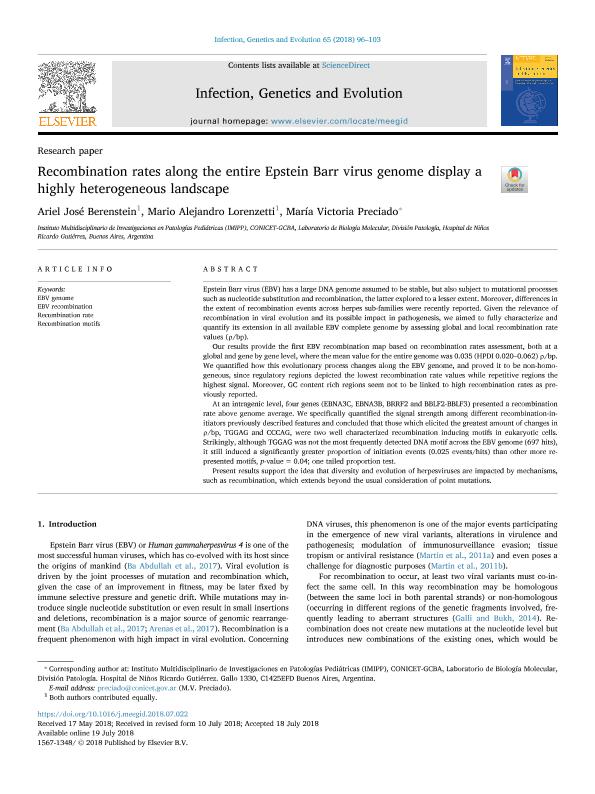Mostrar el registro sencillo del ítem
dc.contributor.author
Berenstein, Ariel José

dc.contributor.author
Lorenzetti, Mario Alejandro

dc.contributor.author
Preciado, María Victoria

dc.date.available
2021-06-08T13:03:53Z
dc.date.issued
2018-07
dc.identifier.citation
Berenstein, Ariel José; Lorenzetti, Mario Alejandro; Preciado, María Victoria; Recombination rates along the entire Epstein Barr virus genome display a highly heterogeneous landscape; Elsevier Science; Infection, Genetics and Evolution; 7-2018; 96-103
dc.identifier.issn
1567-1348
dc.identifier.uri
http://hdl.handle.net/11336/133397
dc.description.abstract
Epstein Barr virus (EBV) has a large DNA genome assumed to be stable, but also subject to mutational processes such as nucleotide substitution and recombination, the latter explored to a lesser extent. Moreover, differences in the extent of recombination events across herpes sub-families were recently reported. Given the relevance of recombination in viral evolution and its possible impact in pathogenesis, we aimed to fully characterize and quantify its extension in all available EBV complete genome by assessing global and local recombination rate values (⍴/bp).Our results provide the first EBV recombination map based on recombination rates assessment, both at a global and gene by gene level, where the mean value for the entire genome was 0.035 (HPDI 0.020-0.062) ⍴/bp. We quantified how this evolutionary process changes along the EBV genome, and proved it to be non-homogeneous, since regulatory regions depicted the lowest recombination rate values while repetitive regions the highest signal. Moreover, GC content rich regions seem not to be linked to high recombination rates as previously reported.At an intragenic level, four genes (EBNA3C, EBNA3B, BRRF2 and BBLF2-BBLF3) presented a recombination rate above genome average. We specifically quantified the signal strength among different recombination-initiators previously described features and concluded that those which elicited the greatest amount of changes in ⍴/bp, TGGAG and CCCAG, were two well characterized recombination inducing motifs in eukaryotic cells. Strikingly, although TGGAG was not the most frequently detected DNA motif across the EBV genome (697 hits), it still induced a significantly greater proportion of initiation events (0.025 events/hits) than other more represented motifs, p-value = 0.04; one tailed proportion test.Present results support the idea that diversity and evolution of herpesviruses are impacted by mechanisms, such as recombination, which extends beyond the usual consideration of point mutations.
dc.format
application/pdf
dc.language.iso
eng
dc.publisher
Elsevier Science

dc.rights
info:eu-repo/semantics/openAccess
dc.rights.uri
https://creativecommons.org/licenses/by-nc-sa/2.5/ar/
dc.subject
EPSTEIN BARR VIRUS
dc.subject
RECOMBINATION RATE
dc.subject.classification
Otras Medicina Básica

dc.subject.classification
Medicina Básica

dc.subject.classification
CIENCIAS MÉDICAS Y DE LA SALUD

dc.title
Recombination rates along the entire Epstein Barr virus genome display a highly heterogeneous landscape
dc.type
info:eu-repo/semantics/article
dc.type
info:ar-repo/semantics/artículo
dc.type
info:eu-repo/semantics/publishedVersion
dc.date.updated
2019-10-21T18:57:14Z
dc.journal.pagination
96-103
dc.journal.pais
Países Bajos

dc.journal.ciudad
Amsterdam
dc.description.fil
Fil: Berenstein, Ariel José. Gobierno de la Ciudad de Buenos Aires. Instituto Multidisciplinario de Investigaciones en Patologías Pediátricas. Consejo Nacional de Investigaciones Científicas y Técnicas. Oficina de Coordinación Administrativa Houssay. Instituto Multidisciplinario de Investigaciones en Patologías Pediátricas; Argentina
dc.description.fil
Fil: Lorenzetti, Mario Alejandro. Gobierno de la Ciudad de Buenos Aires. Instituto Multidisciplinario de Investigaciones en Patologías Pediátricas. Consejo Nacional de Investigaciones Científicas y Técnicas. Oficina de Coordinación Administrativa Houssay. Instituto Multidisciplinario de Investigaciones en Patologías Pediátricas; Argentina
dc.description.fil
Fil: Preciado, María Victoria. Gobierno de la Ciudad de Buenos Aires. Instituto Multidisciplinario de Investigaciones en Patologías Pediátricas. Consejo Nacional de Investigaciones Científicas y Técnicas. Oficina de Coordinación Administrativa Houssay. Instituto Multidisciplinario de Investigaciones en Patologías Pediátricas; Argentina
dc.journal.title
Infection, Genetics and Evolution

dc.relation.alternativeid
info:eu-repo/semantics/altIdentifier/url/https://linkinghub.elsevier.com/retrieve/pii/S1567134818302843
dc.relation.alternativeid
info:eu-repo/semantics/altIdentifier/doi/http://dx.doi.org/10.1016/j.meegid.2018.07.022
Archivos asociados
